左右菜单联动
Code
源码传送门:Rain120/vue-study
根据掘金评论需求,更新了数据接口并修复了一些问题
之前在外卖软件上看到这个左右联动的效果,觉得很有意思,所以就尝试使用Vue来实现,将这个联动抽离成为一个单独的组件,废话少说,先来一张效果图。
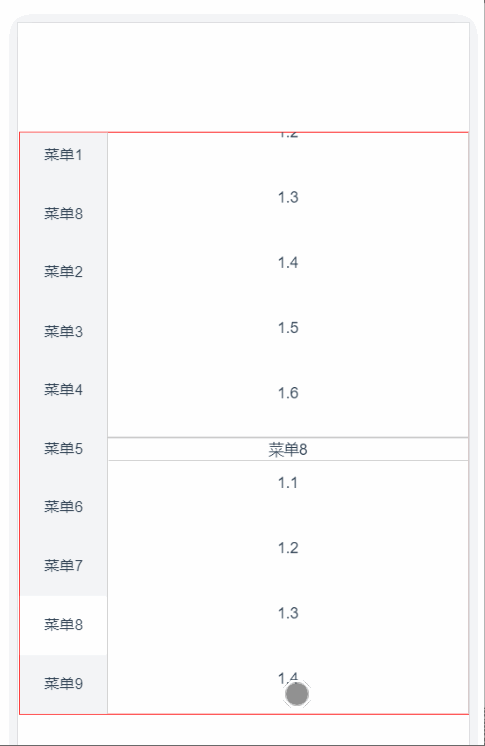
这个组件分为两个部分,1、左菜单;2、右菜单。
动态数据结构
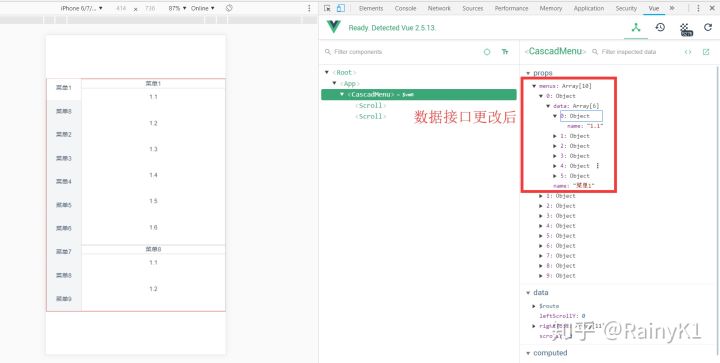
menus: [
{
name: '菜单1',
data: [
{
name: '1.1'
},
{
name: '1.2'
},
{
name: '1.3'
},
{
name: '1.4'
},
{
name: '1.5'
},
{
name: '1.6'
}
]
}
]
data数据是用户自定义增加一些内容,并渲染DOM
左菜单的DOM结构
<scroll
class="left-menu"
:data="menus"
ref="leftMenu">
<div class="left-menu-container">
<ul>
<li
class="left-item"
ref="leftItem"
:class="{'current': currentIndex === index}"
@click="selectLeft(index, $event)"
v-for="(menu, index) in menus"
:key="index">
<p class="text">{{menu.name}}</p>
</li>
</ul>
</div>
</scroll>
右菜单的DOM结构
<scroll
class="right-menu"
:data="menus"
ref="rightMenu"
@scroll="scrollHeight"
:listenScroll="true"
:probeType="3">
<div class="right-menu-container">
<ul>
<li class="right-item" ref="rightItem" v-for="(menu, i) in menus" :key="i">
<div class="title">{{menu.name}}</div>
<ul>
<li v-for="(item, j) in menu.data" :key="j">
<div class="data-wrapper">
<div class="data">{{item.name}}</div>
</div>
</li>
</ul>
</li>
</ul>
</div>
</scroll>
这里是为了做demo,所以在数据上只是单纯捏造。
当然因为这是个子组件,我们将通过父组件传递props,所以定义props
props: {
menus: {
required: true,
type: Array,
default () {
return []
}
}
},

在这个业务场景中,我们的实现方式是根据右边菜单滚动的高度来计算左边菜单的位置,当然左边菜单也可以通过点击来确定右边菜单需要滚动多高的距离,那么我们如何获得该容器滚动的距离呢?
之前一直在使用better-scroll,通过阅读文档,我们知道它有有scroll事件,我们可以通过监听这个事件来获取滚动的pos

if (this.listenScroll) {
let me = this
this.scroll.on('scroll', (pos) => {
me.$emit('scroll', pos)
})
}
所以我们在右边菜单的scroll组件上监听scroll事件
@scroll="scrollHeight"
method
scrollHeight (pos) {
console.log(pos);
this.scrollY = Math.abs(Math.round(pos.y))
},
我们将监听得到的pos打出来看看
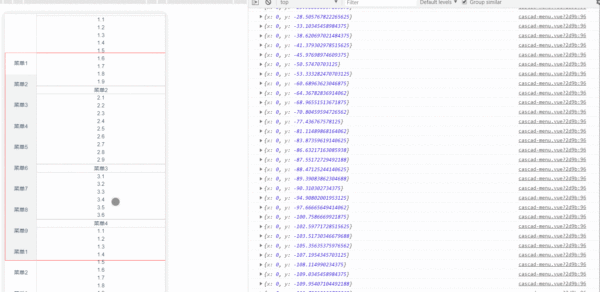
我们可以看到控制台打出了当前滚动的pos信息,因为在移动端开发时,坐标轴和我们数学中的坐标轴相反,所以上滑时y轴的值是负数
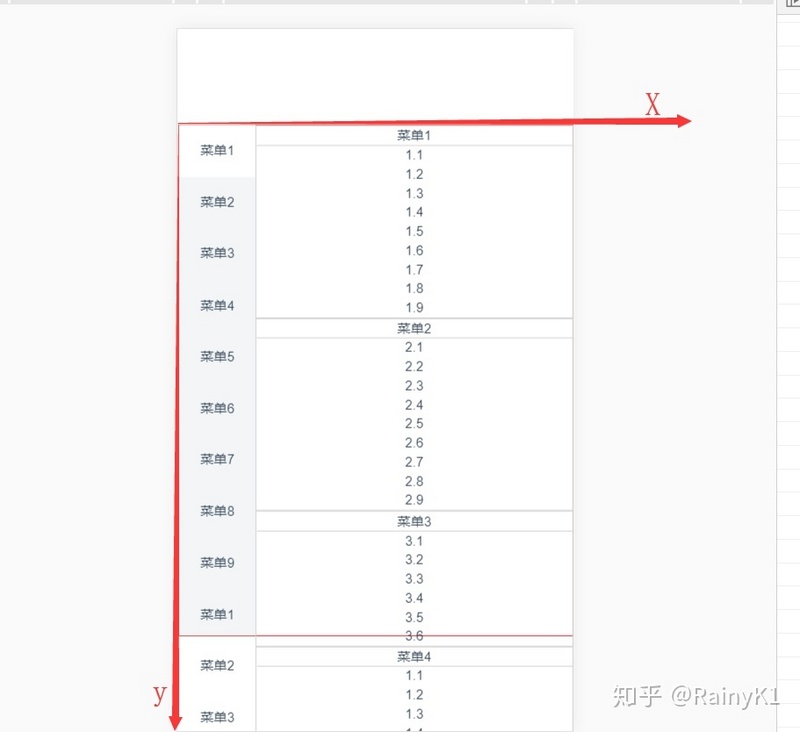
所以我们要得到每一块li的高度,我们可以通过拿到他们的DOM
_calculateHeight() {
let lis = this.$refs.rightItem;
let height = 0
this.rightHeight.push(height)
Array.prototype.slice.call(lis).forEach(li => {
height += li.clientHeight
this.rightHeight.push(height)
})
console.log(this.rightHeight)
}
我们在created这个hook之后调用这个计算高度的函数
_calculateHeight() {
let lis = this.$refs.rightItem;
let height = 0
this.rightHeight.push(height)
Array.prototype.slice.call(lis).forEach(li => {
height += li.clientHeight
this.rightHeight.push(height)
})
console.log(this.rightHeight)
}
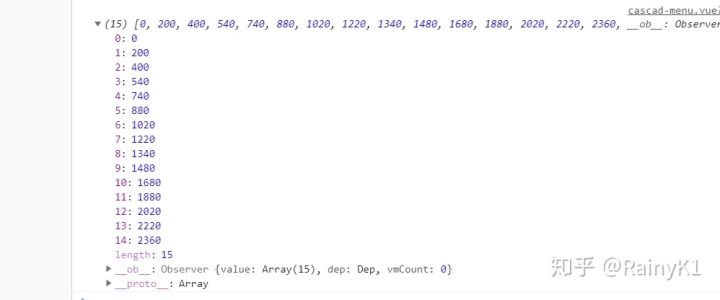
当用户在滚动时,我们需要计算当前滚动距离实在那个区间内,并拿到他的index
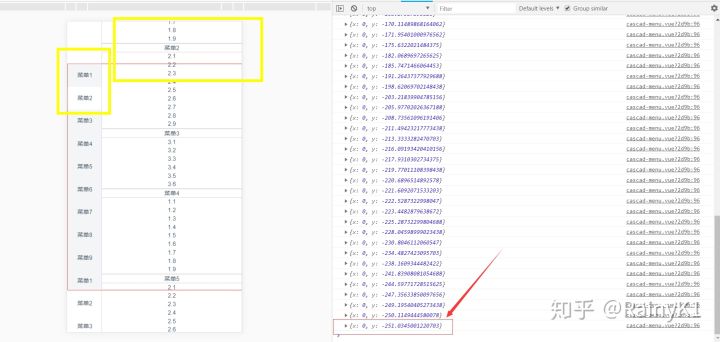

computed: {
currentIndex () {
const { scrollY, rightHeight } = this
const index = rightHeight.findIndex((height, index) => {
return scrollY >= rightHeight[index] && scrollY < rightHeight[index + 1]
})
return index > 0 ? index : 0
}
}
所以当前应该是左边菜单index = 1的菜单项active
以上是左边菜单根据右边菜单的滑动联动的实现,用户也可以通过点击左边菜单来实现右边菜单的联动,此时,我们给菜单项加上click事件
@click="selectLeft(index, $event)"
这里加上$event是为了区分原生点击事件还是better-scroll派发的事件
selectLeft (index, event) {
if (!event._constructed) {
return
}
let rightItem = this.$refs.rightItem
let el = rightItem[index]
this.$refs.rightMenu.scrollToElement(el, 300)
},
使用
<cascad-menu :menus="menus"></cascad-menu>
到这里我们就基本上完成了这些需求了